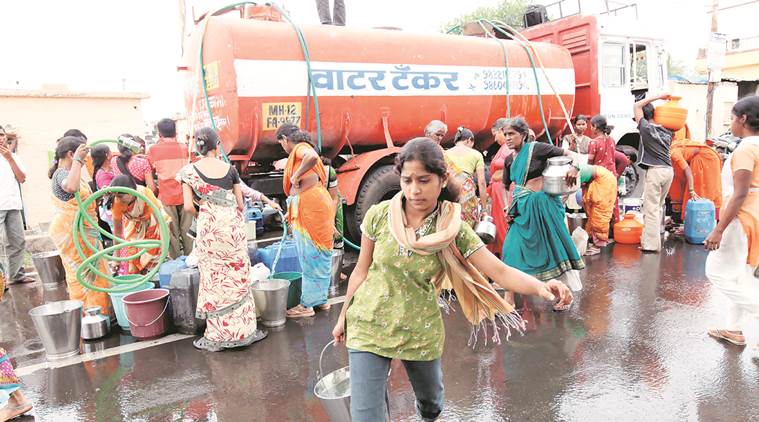- India
- International
Already, over 1,300 tankers in Marathwada’s villages
As some regions have reported acute water and fodder scarcity, the first government-run fodder camps for livestock will be operationalised soon, starting with Beed and Aurangabad districts, officials confirmed.
 As of February 21, as many as 1,381 tankers were providing drinking water to 1,057 villages and 341 hamlets in the eight districts that comprise the region. (File)
As of February 21, as many as 1,381 tankers were providing drinking water to 1,057 villages and 341 hamlets in the eight districts that comprise the region. (File)
With the summer setting in and water scarcity becoming more acute in the drought-hit talukas of arid Marathwada, over 1,000 villages or about a fifth of the region’s drought-hit villages are already dependent on tankers for supply of drinking water. As of February 21, as many as 1,381 tankers were providing drinking water to 1,057 villages and 341 hamlets in the eight districts that comprise the region.
As some regions have reported acute water and fodder scarcity, the first government-run fodder camps for livestock will be operationalised soon, starting with Beed and Aurangabad districts, officials confirmed.
In the Marathwada region, the state government has declared drought in 5,517 villages, or nearly 60 per cent of the region. The most acute water scarcity is currently being witnessed in Gangapur, Vaijapur, Paithan, Sillod and Aurangabad talukas of Aurangabad; Ashti, Beed, Georai and Shirur-Kasar talukas in Beed; and Bhokardan, Jafrabad and Ambad talukas in Jalna. Several towns in these districts are receiving water supply once in 7-10 days.
As many as 707 tankers are currently operational in Aurangabad district alone, including 137 in Gangapur taluka and 129 in Sillod. Beed district currently has 396 operational tankers, including 108 in worst-hit Ashti taluka.
Earlier, a Ground Water Survey and Development Agency (GSDA) report released late in 2018 had found that 4,385 villages in 58 talukas of Marathwada had witnessed a dip in ground water levels by more than one metre from five-year averages. Of these, 1,411 villages showed groundwater depletion at alarming levels, a dip of more than 3 metres from the average.

In these talukas, officials have been instructed to check for any water supply schemes that can be expeditiously repaired or completed in order to provide water. “During the 2012 drought, officials in Beed district ordered wells to be dug inside water sources such as riverbeds, this will be plan B if the scarcity worsens,” said an IAS officer. Across the region, district administrations have been told to crack down on any siphoning of water.
As water sources in these villages dry up, the government has also begun to take control of private wells. As of February 21, this acquisition included 1,850 wells in 1,460 villages, including 602 in Beed and 399 in Aurangabad. The drying of water sources for water tankers is already a grave challenge in Beed, said officials.
Meanwhile, officials at the office of the Divisional Commissioner in Aurangabad confirmed that a second tranche of aid for distressed farmers who reported crop loss in the kharif 2018 season is currently being disbursed. Of the total Rs 1,050 crore assistance received from the state government for the purpose, 51.08 per cent is already disbursed.
Apr 25: Latest News
- 01
- 02
- 03
- 04
- 05








































